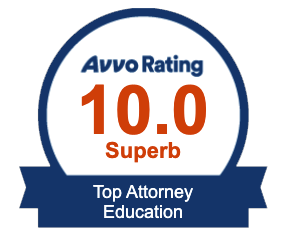THE SCHOOL BELL ENDS: HOW TO BEGIN DEVELOPING
YOUR CHILD’S INDIVIDUALIZED EDUCATION PROGRAM FOR THE 2014-2015 SCHOOL YEAR1
BY: TORIN D. TOGUT
As the school year ends, parents should review, revise, or revisit their child’s Individualized Education Program (IEP) for 2014-2015 school year. The IEP is the child’s educational roadmap for school year. Parents should be familiar with their child’s instruction, services, and placement for the school year as well as how the school system intends to document their child’s educational progress.
There are a few preliminary steps to take before the IEP meeting that will be helpful to parents. First, parents should determine appropriate goals and objectives for their child as well as classroom accommodations and related services such as occupational therapy, physical therapy, speech and language therapy and special transportation that will benefit their child’s special education programming. Second, the parents should be familiar with all educational records of your child before the IEP meeting. These records, include but are not limited to, private and school evaluations of any kind or nature, disciplinary reports and referrals, behavior intervention plans, transition plans, if appropriate, and any other record and document that may affect the special educational programming of your child. Finally, it is important for parents to learn educational jargon that is often used at IEP meetings. With specialized knowledge of educational jargon, parents will be more effective advocates for their child with disabilities at an IEP meeting.
PRACTICAL TIPS FOR DEVELOPING AN IEP
A. Present Levels of Performance
The purpose of determining the child’s present level of performance is to determine a baseline which can be compared against past, present, and future school years. Some school systems indicate a child’s present level of performance in a narrative form and provide some objectives test scores. The most statistically significant and objective indicator of a child performance on standardized or nationally-normed tests are standard scores. Grade equivalent and age equivalent scores may provide a general barometer of where the child is functioning but these scores are not reliable to precisely determine a child’s intelligence, ability, or functioning level. The child’s level of performance should also mention, if applicable, the child’s behavior, cognitive abilities, self-help skills, social skills, independent life skills, communicative skills, vocational skills, psychiatric and psychological diagnoses and disorders, if any, and other ecological information that is pertinent to the child’s educational performance.
B. Annual Goals
Annual goals for a child are statements that describe what a child with a disability is expected to achieve within a school year. The goals should be determined from assessing the child’s present level of performance, and from information gathered from evaluations, tests scores, grades, and past performance on IEP goals. Goals must be objective and measurable. Parents should be aware of goals that are canned, boilerplate and generalized such as “Linda will increase reading skills,” or “Carl will improve his behavior.” On the other hand, carefully drafted goals can be useful in improving a child’s educational performance. A positive example of an IEP goal is “Rolando will self-toilet with one verbal prompt.”
C. Short Term Objectives
Short-term objectives should be linked with each of the annual goals. The short-term objectives are more specific. There is no established number of short-term objectives for each IEP goal. The number of short-term objectives will vary depending upon the child’s abilities, strengths and weaknesses, and annual goal.
Short-term objectives should be measurable. Short term objectives can be used to measure what the child will accomplish within specific integrals of time. For example, Jeffrey will complete a sentence correctly 3 out of 4 times by the end of the school year. The percentages or attempts used should be based ability and performance.
D. Related Services
In general, related services are those services necessary for the child with a disability to benefit from special education instruction. The term “related services” includes transportation, speech pathology and audiology, psychological services, physical and occupational therapy, recreation, counseling services, including rehabilitation counseling, and medical services for diagnostic or evaluation purposes, school health services in schools, and parent counseling and training. Many school districts will accept an independent evaluation from a certified speech and language, occupational and physical therapist in order to qualify a child with a disability for related services. The school district, however, can conduct its own evaluation to determine the need for related services.
E. Least Restrictive Environment
The terms of mainstreaming, least restrictive environment, and inclusion for a child with a disability under the IDEA do not mean the same thing. Parents should focus on the meaning of least restrictive environment at IEP meetings.
Least restrictive environment means that children with disabilities should be educated with non-disabled peers to the maximum extent appropriate unless the school system can show that the child’s educational needs cannot be satisfactorily met in a regular education classroom without supplementary aids and services. The IEP committee should compare the educational benefits your child will receive in the regular classroom with supplemental aides and services with the educational benefits the child will receive in more restrictive classroom setting; the adverse effect, if any, your child will have on other children in the regular education classroom; and consider the cost of supplemental aides and services necessary to achieve your child’s satisfactory education in the regular classroom.
F. Extended School Year Programming (ESYP)
Extended School Year Programming or sometimes referred to as ESY is an important component of an IEP meeting for the end of the school year. ESY is usually for students that have a moderate or severe disability that suffer regression during the summer months and have delayed recoupment of instruction and skills at the beginning of the next school year. Regression and recoupment are not the only criteria for ESY. Emerging skills, maintenance of progress on IEP goals and objectives, and severity of disability are some of the other considerations for the IEP team to consider for ESY. Also ESY cannot be artificially and arbitrarily limited to a couple of weeks during the summer for a few hours a week. ESY must be based upon the individual needs of the student. The provision of ESY can be critical for your child. Parents should advocate for ESY for their child during the development of an IEP for next school year.
V. CONCLUSION
This article only briefly touches upon a few essential components of an IEP. There are many more items for parents to consider in developing an IEP. Importantly, at the completion of the child’s IEP, the parents should feel the IEP meets the special educational needs of their child. Parents should not agree to boilerplate provisions proposed by the school system that do not address the unique educational needs of their child. In the end, it is parent’s decision to accept or reject the IEP.
The Law Office of Torin D. Togut may be reached at 678-372-1829 or by email torin@togutlaw.com
1 The discussion of practical tips for developing an IEP is not an exhaustive examination of the subject area, and of every conceivable item that could be discussed at an IEP meeting. The suggestions, comments and opinions expressed in this section are based on the experience of the author of this outline and do not necessarily reflect the opinions of others who regularly practice in this area. This outline should not be considered legal advice and a parent’s reliance on it does not constitute an attorney-client relationship. Parents are advised to consult with an experienced advocate or attorney in your own state for advice and information on how to develop an appropriate IEP for their child.

